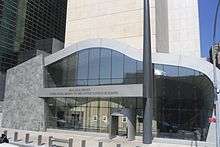United States Mission to the United Nations
The United States Mission to the United Nations (USUN) serves as the United States' delegation to the United Nations.[1] USUN is responsible for carrying out the nation’s participation in the world body. In 1947 the United States Mission was created by an act of Congress to assist the President and the Department of State in conducting United States policy at the United Nations. Since that time, USUN has served a vital role as the Department of State’s UN branch. Today, USUN has approximately 150 people on staff who serve to represent the United States’ political, economic and social, legal, military, public diplomacy and management interests at the United Nations.
| Permanent Mission of the United States to the United Nations | |
|---|---|
 | |
 | |
| Type | Diplomatic mission |
| Status | Active |
| Appointer | President of the United States with Senate advice and consent |
| Formation | 1945 |
| First holder | Edward Stettinius Jr. |
| Website | usun.state.gov |
USUN is divided into the following sections – Executive; Washington; Political; Management and Reform; Economic and Social; Legal; Military Staff; Public Affairs; Host Country; Management; and Security.
The United States Mission to the United Nations is located at 799 United Nations Plaza (between E. 44th and E. 45th on First Ave) across the street from United Nations Headquarters.
Leadership
There are several major leadership roles in the US Mission.[2] The primary role, United States Ambassador to the United Nations, is the leader of the U.S Mission to the United Nations. The position is more formally known by the exact title:
- "Permanent Representative of the United States of America to the United Nations, with the rank and status of Ambassador Extraordinary and Plenipotentiary, and Representative of the United States of America in the Security Council of the United Nations".
The position is also known as simply the US Permanent Representative, or "Perm Rep", to the United Nations.
The U.S. Permanent Representative, currently Kelly Craft, is charged with representing the United States on the UN Security Council and during almost all plenary meetings of the General Assembly, except in the rare situation in which a more senior officer of the United States (such as the U.S. Secretary of State or the President of the United States) is present. Like all United States ambassadors, he or she must be nominated by the U.S. President and confirmed by the Senate.
Many prominent U.S. politicians and diplomats have held the post, including Henry Cabot Lodge, Jr., Adlai Stevenson, George H. W. Bush, Daniel Patrick Moynihan, Dr. Jeane Kirkpatrick, Richard Holbrooke, Dr. Madeleine Albright, Bill Richardson and John Danforth.
It was a cabinet-level position under the Clinton administration and the Obama administration, but no longer holds that status under the Trump administration. It was not a cabinet-level position under the George W. Bush administration (from 2001 to 2009).[3][4]
The other leadership roles are also known as UN ambassadors, but with specific titles as related to which offices of the UN they handle.
Congressional Representatives to the United Nations
The U.S. President also appoints two members of the United States House of Representatives and two Senators - one Democrat and one Republican from each chamber - as Congressional Representatives to the United Nations General Assembly. The position is regulated by Section 2(a) of the United Nations Participation Act, which stipulates that the President can appoint no more than five members of Congress to the General Assembly with the advice and consent of the Senate and that members appointed to the Assembly can not be compensated for their service in the Assembly. The duties of Congressional Representatives are not specified by the UNPA, but they generally act as observers in the committee proceedings and formal gatherings of UNGA members and heads of state.[5]
Building
The new building housing the United States Mission to the United Nations, at First Avenue and East 45th Street in Turtle Bay, Manhattan, was dedicated on March 29, 2011. The lead architect was Charles Gwathmey of Gwathmey Siegel & Associates Architects who died in 2009, approximately two years before the structure was completed. Former U.S. Permanent Representative Susan Rice posthumously thanked Gwathmey in her remarks at the dedication ceremony.
See also
- Member states of the United Nations
- United Kingdom Mission to the United Nations
- Diplomatic Security Service
- Senior Foreign Service
References
- "About the Mission". United States Mission to the United Nations. Retrieved 2019-08-19.
- "Welcome to the United States Mission to the United Nations", USUN.state.gov, March 2011, webpage: state.gov-913 Archived 2011-02-10 at the Wayback Machine.
- Kelemen, Michele (December 1, 2008). "U.N. Envoy Nominee Rice Known As Smart, Tough". National Public Radio. Retrieved January 21, 2009.
The head of the United Nations Foundation, a Washington-based advocacy group, released a statement praising Rice as well as Obama's decision to make the post of U.N. ambassador a Cabinet-level position once again — as it was during the Clinton years.
- Cooper, Helene (November 20, 2008). "Clinton Decision Holding Up Other Obama Choices". The New York Times. Retrieved February 9, 2009.
Ms. Rice could get the post of United States ambassador to the United Nations, a cabinet-level position under President Clinton. President Bush downgraded the position when he came into office
.
External links
| Wikimedia Commons has media related to United States missions to the United Nations. |
- Official Website
- - Ambassador Rice's remarks at the dedication of the building